This post may contain affiliate links. Please read our disclosure policy.
Chicken pieces are marinated in a concoction of salt and aromatic spices and herbs and then baked or steamed. The result is tender and juicy meats with briny and fragrant deliciousness.

This recipe I made is inspired by the famous Ipoh salt-baked chicken. I simplified it so that home cooks with any level can easily whip this up at home. This is one of our family’s favorite chicken dishes. I was a bit skeptical if my kids would like it because of the addition of herbals like dong quay in the salt mixture, but they don’t mind it at all.
What is Hakka salt baked/steamed chicken
The chicken is usually marinated in a mixture of salt and Chinese herbs and spices, such as dong quay (female ginseng/Angelica sinensis) , ginger, sand ginger (lesser galangal), and salt. The marinated chicken is then wrapped in paper, covered in a layer of salt, and baked in an oven or charcoal pit until fully cooked.
The use of paper to wrap the chicken is a unique aspect of Ipoh salt-baked chicken, as it helps to trap the moisture and flavors of the chicken while also preventing the salt from penetrating too deeply into the meat. This results in a chicken that is moist, tender, and full of flavor.
Why you’ll like this recipe
The method may not be all traditional but I can ensure you that it still yields really good results and most importantly, is very easy to replicate in your kitchen.
1. I use chicken pieces instead of a whole chicken
I know some people (me included) get intimidated by having to deal with a whole bird. Using pieces like leg quarters or drumsticks is more manageable
2. You don’t need to use a lot of salt
Traditionally the chicken is wrapped in baking paper and then salt is added to cover the entire chicken and then baked. You will need A LOT of salt. Though the salt can be reused later. I choose not to bake (or steam if you choose to) without the salt and the chicken is still really juicy and tender
3. Maximum flavor
I grind the herbs like dong quay (female ginseng/Angelica sinesis) together into a fine powder and mix it with the salt mixture. This really gives a wonderful aroma to every piece of the chicken instead of just putting slices of dong quay on the chicken
Ingredients and substitutions
1. Chicken
I highly recommend using organic chicken if it fits your budget. Ayam kampung or free-range chicken is also suitable to use for this recipe. Alternatively, regular farm-raised chicken can be used too if that’s what you prefer
2. Dong Quay/dong quai
This Chinese herb imparts a good herbal flavor to the overall dish. If you don’t like it, you can definitely skip this.
3. Sand ginger
Sand ginger or known as lesser galangal or kencur is commonly used in Indonesian cooking. It is not easy to find this spice. Not many Asian grocery stores carry this. You can omit if you can’t find any or you can get this dried sand ginger if you want. I don’t use as much sand ginger in this recipe because I want the flavor of dong quay more. There’s no close substitution to sand ginger powder, not even a galangal powder
4. Ginger
I use fresh ginger that I cut into thin slices. Don’t replace it with ginger powder used for baking cookies. They don’t have the same aroma
5. Chicken powder
This is more to enhance the taste. You can omit or also use mushroom or anchovy powder if you have
6. Green onion
We only used the white part of the green onion
Easy Hakka Salt Baked/Steamed Chicken (Ipoh-style)
Ingredients
- 1.5 kg skin-on bone-in chicken thighs (organic if possible) or chicken drumsticks
- 6 stalks green onion white parts only
- 10 gr ginger thinly sliced
- 2 tsp goji berries optional
Seasonings, spices, and herbs:
- ¼ cup fine sea salt
- 8 gr dried dong quay
- ½ tsp ground white pepper
- ½ tsp sand ginger powder
- 1 tsp chicken powder
You also need:
- Parchment papers
- Heavy-duty aluminum foil
Instructions
Prepare the seasonings:
- I use dried dong quay. I put them in a coffee/spice grinder and grind them into fine powder. If you use dried sand ginger, you can do the same by grinding them into fine powder. You can also do this manually with a mortar and pestle if you have one, though the result may not be as fine in texture. Combine the dong quay powder with salt, lesser galangal powder, ground white pepper, and chicken powder
- Combine the dong quay powder with salt, sand ginger powder, ground white pepper, and chicken powder
- Cut ginger into thin slices. Cut the green onion, using only the white parts
Marinate the chicken:
- Pat the chicken really dry on both sides with absorbent paper towel so the seasonings can cling better
- Rub the dry seasonings all over the chicken pieces: the skin, the back side and underneath the skin.
- You can individually wrap the chicken pieces with parchment paper, or wrap 3-4 pieces in one parchment like what I did. It's up to you
- Cut out about 4 pieces of 20 x 20 inches parchment paper. Cut out 2 pieces of 20 x 20 inches of heavy-duty aluminum foil. I use 2 layers of parchment paper and 1 heavy-duty aluminum foil for each wrap
- Arrange some scallion pieces and ginger slices for each chicken piece and put the chicken pieces on top. Add some goji berries on top. This is optional. It's more for visual , but won't hurt having them too.
- Wrap the parchment paper securely over the chicken. Then wrap aluminum foil over the parchment. Make sure the opening of the wrap is on top so you can easily open them up to check on the chicken to see if they are done cooking or not. Repeat with the rest of the chicken pieces
- Put them on a large dish and in the refrigerator to let them marinate for at least 4 hours. It is best if you can do overnight for 8-12 hours
On the day you plan to bake/steam:
- Remove the chicken about 1 hour before you plan to cook so they have a chance to come to room temperature
- If you plan to bake, 30 minutes before you plan to cook, preheat oven to 425 F (220 C) for conventional oven. 400 F (205 c) for convection oven.
- Place the wraps on a baking sheet and bake for 50-60 minutes. Check at 50-minute mark. Carefully unwrap the parcel. I use a digital thermometer to check the doneness. Check at the thickest part of the chicken and internal temperature should be 165 F (74 C). You can also pierce the thickest part of the chicken with a fork or knife and check the color of the juices. If they are clear, the chicken is done. If they are still pink or have a reddish color, it needs to bake longer.
- If you plan to steam, put a trivet in the steamer and fill your steamer with water and bring to a boil.
- Place the parcel on top of the trivet, and steam over high heat for 30 minutes. make sure to check on the water level to see if it needs refill. If you need to refill, make sure you start the time again when the water comes to a boiling.
- Check for doneness at this point. Carefully unwrap the parcel. I use a digital thermometer to check the doneness. Check at the thickest part of the chicken and internal temperature should be 165 F (74 C). You can also pierce the thickest part of the chicken with a fork or knife and check the color of the juices. If they are clear, the chicken is done. If they are still pink or have a reddish color, it needs to steam longer.
Wait 10 minutes before cutting:
- Once the chicken pieces are done baking/steaming. Let them rest in the parcel for 10 minutes. This is to ensure the chicken remains juicy
Serving:
- I remove the bones and then cut the meat into serving size and serve with the juice that is pooling inside the parcel
*Nutrition facts are just estimates and calculated using online tools*
How to cook Hakka salt-baked/steamed chicken
1. I use dried dong quay. I put them in a coffee/spice grinder and grind them into fine powder. If you use dried sand ginger, you can do the same by grinding them into fine powder. You can also do this manually with a mortar and pestle if you have one, though the result may not be as fine in texture. Combine the dong quay powder with salt, lesser galangal powder, ground white pepper, and chicken powder
2. Pat the chicken really dry on both sides with an absorbent paper towel so the seasonings can cling better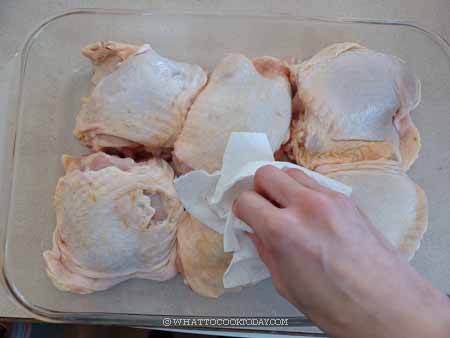
3. Rub the dry seasonings all over the chicken pieces: the skin, the back side and underneath the skin.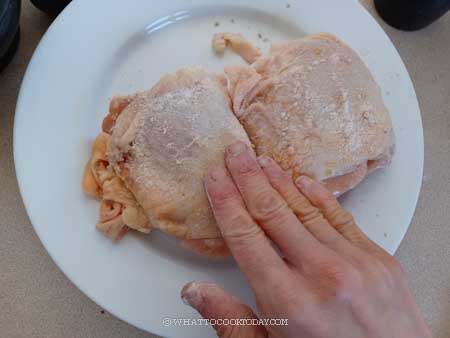
4. You can individually wrap the chicken pieces with parchment paper, or wrap 3-4 pieces in one parchment like what I did. It’s up to you. Cut out about 4 pieces of 20 x 20 inches parchment paper. Cut out 2 pieces of 20 x 20 inches of heavy-duty aluminum foil. I use 2 layers of parchment paper and 1 heavy-duty aluminum foil for each wrap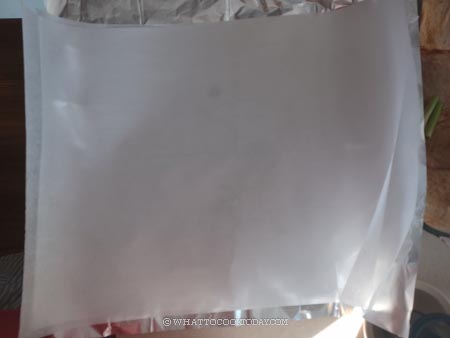
5. Arrange some scallion pieces and ginger slices for each chicken piece and put the chicken pieces on top. Add some goji berries on top if you like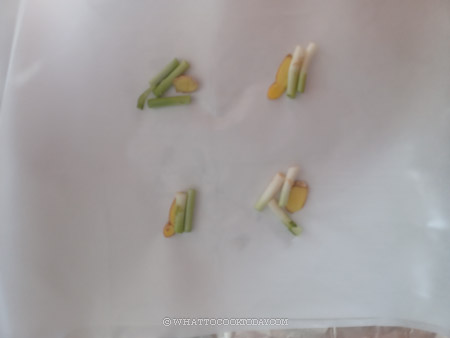
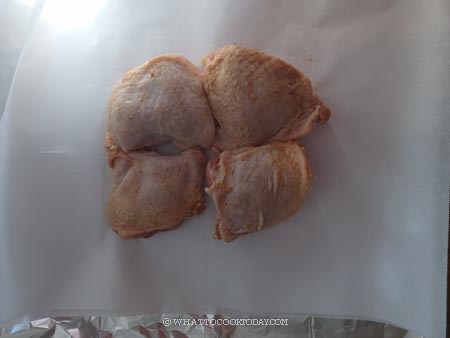
6. Wrap the parchment paper securely over the chicken. Make sure the opening of the wrap is on top so you can easily open them up to check on the chicken to see if they are done cooking or not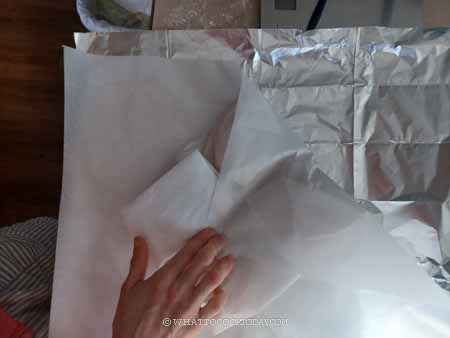
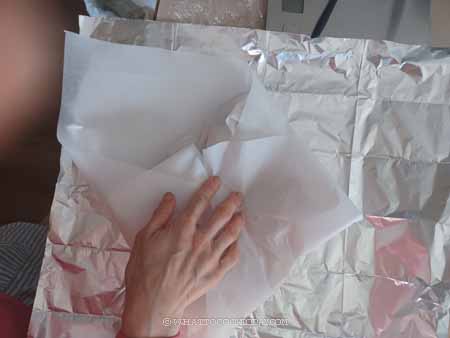
7. Then wrap aluminum foil over the parchment. Make sure the opening of the foil is on top too for the same reason. Repeat with the rest of the chicken pieces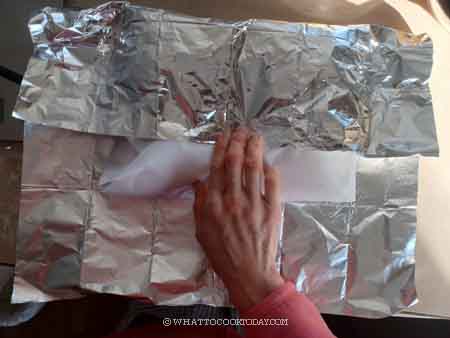
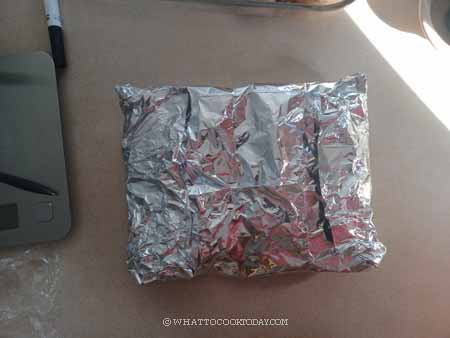
8. Put them in the refrigerator to let them marinate for at least 4 hours. It is best if you can do overnight for 8-12 hours
On the day you plan to bake, remove the chicken about 1 hour before you plan to cook so they have a chance to come to room temperature. If you plan to bake, 30 minutes before you plan to cook, preheat oven to 425 F (220 C) for conventional oven. 400 F (205 c) for convection oven.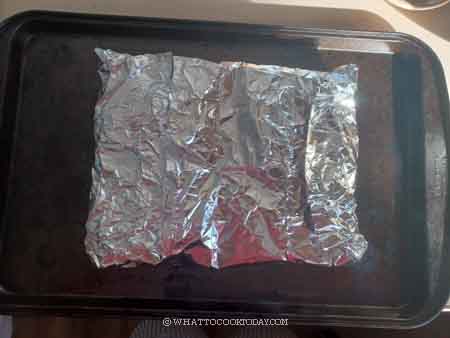
9. Place the wraps on a baking sheet and bake for 50-60 minutes. Check at the 50-minute mark. Carefully unwrap the parcel. I use a digital thermometer to check the doneness.
10. If you plan to steam, put a trivet in the steamer and fill your steamer with water and bring to a boil. Place the parcel on top of the trivet, and steam over high heat for 30 minutes. make sure to check on the water level to see if it needs a refill. If you need to refill, make sure you start the time again when the water comes to a boil.
11. Check the thickest part of the chicken and the internal temperature should be 165 F (74 C). You can also pierce the thickest part of the chicken with a fork or knife and check the color of the juices. If they are clear, the chicken is done. If they are still pink or have a reddish color, it needs to be baked longer.
12. Once the chicken pieces are done baking/steaming. Let them rest in the parcel for 10 minutes. This is to ensure the chicken remains juicy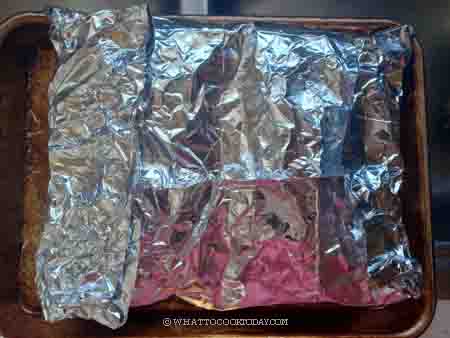
13. To serve, I remove the bones and then cut the meat into serving sizes and serve with the juice that is pooling inside the parcel

How to keep leftovers
1. Let them cool down completely. Store the chicken in an airtight container or wrap it tightly with plastic wrap or aluminum foil to prevent it from drying out and to keep out air and moisture.
2. Keep the skin on If the chicken has skin, leave it on while storing it. The skin helps to keep the moisture in and prevents the chicken from drying out.
3. Store it with the juice: Store the chicken with some of the juices or cooking liquid to help keep it moist. This can be done by spooning some of the liquid into the container with the chicken or by placing the chicken in a shallow dish with some liquid.
How to reheat leftovers
1. I recommend using moist heat such as steaming to avoid further moisture loss.
2. If you reheat in the oven, wrap it with foil and some of the juice or chicken broth. Reheat at 350 F (180 C) for 15-20 minutes or until warm.
3. If you reheat in the microwave, place the chicken on a microwave-safe plate and then cover the chicken with a damp paper towel. Use 50% power as we want to reheat it gently. Reheat in 1-minute increments until heated through


2 comments
This recipe you bake without the salt or bake with the salt. I am abit confused.
Yes, you rub the chicken pieces with the seasoning, which includes salt.